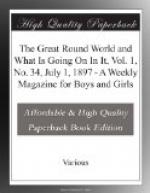Annexing means joining to. You know what an annex to a house is—that it is a few extra rooms built beside the house, and joined permanently to it. When one country annexes another it makes it part of itself. The new lands are permanently joined to the old, and are regarded as a part of the whole.
President McKinley has expressed himself as in favor of annexing Hawaii, and has been considering the matter for some time. He did not wish that anything should interfere with the Tariff Bill, and for this reason kept Hawaiian matters in the background, along with Cuban affairs, until the Tariff question should be settled.
The trouble with Japan has forced him to consider Hawaiian Annexation before he intended to, and so the treaty has been drawn up.
He is more willing to give the matter his attention at the present time, because he finds that Hawaiian affairs are really delaying the Tariff Bill.
A great deal of our sugar is imported from the Hawaiian Islands, and under a commercial treaty made between Hawaii and the United States this sugar is brought into our country free of duty.
There is a clause in the treaty which says that the President can terminate it whenever he wishes to, by giving due notice.
In considering the sugar tariff, it was necessary for the Senators to decide whether Hawaiian sugar should still be admitted free of charge, or should be subject to the same duties as other sugars.
The Senators could not come to any agreement until they knew whether the President meant to end the treaty—abrogate it, as it is called.
Not wishing to delay the Tariff Bill, the President thought the wisest thing to do would be to let the Senate know that he was in favor of annexing Hawaii.
With Hawaii a part of this country, the sugar question would settle itself, and the Tariff Bill could go on undisturbed.
Before the President allowed any word of his intentions to become known, he called a Cabinet meeting and laid the treaty before his ministers.
The majority of the Cabinet approved of the draft of the treaty that was read to them, and it is thought that the Senate will also look favorably on the measure, and that the necessary two-thirds vote will be secured without trouble.
The treaty provides that the United States shall become possessed of all the public lands and buildings, ships, ports, etc., belonging to Hawaii, and shall in return assume Hawaii’s debts, which amount to $4,000,000.
This treaty does not provide any pension for the ex-queen, Liliuokalani, nor any gift of money for the Princess Kiaulani.
The treaty proposed in 1893, which was rejected by Mr. Cleveland, provided liberally for both. You can read all about it on page 734 of THE GREAT ROUND WORLD.
Queen Liliuokalani is not at all disturbed by the talk of annexation. She has been in Washington all the winter, trying to make friends of the Senators, so that they will oppose the treaty when it is brought before them.




